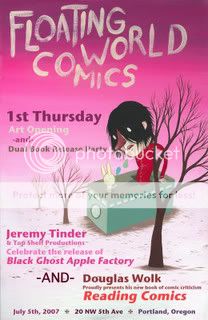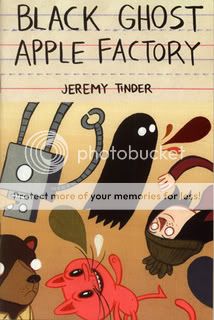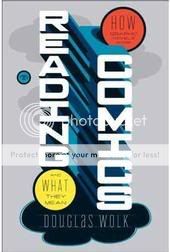This First Thursday, July 5th, Floating World Comics and Top Shelf are proud to present a dual book release party with Jeremy Tinder and Douglas Wolk!

Jeremy Tinder presents dozens of new paintings and debuts his new comic, “BLACK GHOST APPLE FACTORY” from Top Shelf Productions.
Douglas Wolk will be on hand to present and discuss his new book on comic criticism and appreciation, “READING COMICS”.
Plus new paintings by local artist Tripper Dungan III and an elaborate art show by local collective, ALARMING PRESS.
Opening Reception: First Thursday, July 5, 2007 / Time: 6:30 – 10 pm
***
Praise for Jeremy Tinder’s, “BLACK GHOST APPLE FACTORY”:

Jeremy Tinder deals in sadness. He writes books with titles like Cry Yourself to Sleep, covering his canvas with broad, blue brush strokes—but, much to the artist’s credit, sadness is never the ultimate sum of Tinder’s equations, instead these stories, even those that center around the lives of anthropomorphic animal, points to some hilarious universal absurdity of the human condition.
Black Ghost Apple Factory is an incredibly likable little collection, despite its tendency to wallow in some of our most regrettable emotions. It’s a too-short showcase of an underground cartoonist who is at the top of his game, in the world of short form.

Praise for Douglas Wolk’s “READING COMICS”
From Publishers Weekly
As the graphic novel flourishes and gains legitimacy as an art form, serious comics criticism is an inevitable byproduct, and PW contributing editor Wolk’s analytical discourse is a welcome starting point. The volume contains two sections: Theory and History, an explanation of comics as a medium and an overview of its evolution, and Reviews and Commentary, a diverse examination of creators and works. This section spans Will Eisner’s pioneering efforts as well as the groundbreaking modern comics by the Hernandez brothers, Chris Ware and Alison Bechdel.
Since there are decades worth of books already focusing on the superhero genre, the raw clay from which the comics industry was built, the relatively short shrift given to the spandex oeuvre’s insular mythologies is a wise choice that allows the nonfan a glimpse into the wider range that comics commands. Wolk’s insightful observations offer much to ponder, perhaps more than can be fully addressed in one volume, but the thoughtful criticism and knowledgeable historical overview give much-needed context for the emerging medium.